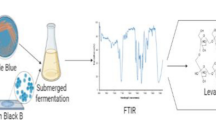Abstract
As a follow-up to earlier studies on the emission of long-chain alcohols from broth cultures of Gram-negative enteric bacteria, E. coli was examined for the production of 1-octanol, 1-decanol, and 1-dodecanol. Ten strains of E. coli cultured in tryptic soy broth were assayed for volatile metabolites using solid-phase microextraction. Long-chain alcohols were produced by all strains with 1-decanol predominating with production ranging from 23.6 ng mL−1 to 148 ng mL−1. The production of long-chain alcohols followed the onset of the exponential growth phase of the broth culture. Doubling the concentration of glucose (5 g L−1) in the broth had no effect on the concentration of long-chain alcohols produced. Addition of octanoic, decanoic, or dodecanoic acids (as K+ salts) to the broth (100 mg L−1) markedly increased the production of the corresponding alcohols by E. coli, ranging from a 13-fold increase for decanol to a 51-fold increase for dodecanol. However, decanol remained the predominant alcohol detected in all assays. These neutral volatile alcohols may have application as vapor-phase indicators for certain classes of bacteria, particularly, Gram-negative enteric bacteria.

Similar content being viewed by others
Literature Cited
CL Arthur C Pawliszyn (1990) ArticleTitleSolid-phase microextraction with thermal desorption using fixed silica optical fibers Anal Chem 62 2145–2148 Occurrence Handle10.1021/ac00218a019
RH Dainty RA Edwards CM Hibbard (1984) ArticleTitleVolatile compounds associated with the aerobic growth of some Pseudomonas species on beef J Appl Bacteriol 57 75–81 Occurrence Handle6490566
H Elgaali TR Hamilton-Kemp MC Newman RW Collins K Yu DD Archbold (2002) ArticleTitleComparison of long-chain alcohols and other volatile compounds emitted from food-borne and related Gram-positive and Gram-negative bacteria J Basic Microbiol 42 373–380 Occurrence Handle10.1002/1521-4028(200212)42:6<373::AID-JOBM373>3.0.CO;2-4 Occurrence Handle12442299
H Gershon L Shanks (1980) ArticleTitleAntifungal properties of n-alcohols, α, ω-alkanediols, and ω-chloro-α-alcohols J Pharm Sci 69 381–384 Occurrence Handle7373528
N Kabelitz PM Santos HH Heipieper (2003) ArticleTitleEffect of aliphatic alcohols on growth and degree of saturation of membrane lipids in Acinetobacter calcoaceticus FEMS Microbiol Lett 220 223–227 Occurrence Handle10.1016/S0378-1097(03)00103-4 Occurrence Handle12670684
EN Konaman SD Allen WM Janda PC Schreckenberger WC Winn SuffixJr (1997) Color atlas and textbook of diagnostic microbiology EditionNumber5 Philadelphia Lippincott
I Kubo T Fujita A Kubo K Fujita (2003) ArticleTitleModes of antifungal action of alcohols against Saccharomyces cerevisiae Biorg Med Chem 11 1117–1122 Occurrence Handle10.1016/S0968-0896(02)00453-4
I Kubo H Muroi A Kubo (1995) ArticleTitleStructural functions of antimicrobial long-chain alcohols and phenols Biorg Med Chem 3 873–880 Occurrence Handle10.1016/0968-0896(95)00081-Q
JN Labows KJ McGinley GF Webster JJ Leyden (1980) ArticleTitleHeadspace analysis of volatile metabolites of Pseudomonas aeruginosa and related species by gas chromatography-mass spectrometry J Clin Microbiol 12 521–526 Occurrence Handle6775012
WF Naccarato JR Gilbertson RA Gelman (1974) ArticleTitleIn vivo and in vitro biosynthesis of free fatty alcohols in Escherichia coli K−12 Lipids 9 419–428 Occurrence Handle4366226
HP Nalik KD Muller R Ansorg (1992) ArticleTitleRapid identification of Legionella species from a single colony by gas-liquid chromatography with trimethylsulphonium hydroxide for transesterification J Med Microbiol 36 371–376 Occurrence Handle1613774
M Sasser MD Wichman (1991) Identification of microorganisms through use of gas chromatography and high performance liquid chromatography A Balows WJ Hausler KL Herrmann HD Isenberg (Eds) Manual of clinical microbiology EditionNumber5 American Society for Microbiology Washington, DC . 111–116
C Scholler S Molen K Wilkens (1997) ArticleTitleVolatile metabolites from some Gram-negative bacteria Chemosphere 35 1487–1495 Occurrence Handle10.1016/S0045-6535(97)00209-9 Occurrence Handle9314189
DN Suprapta K Arai H Iwai (1997) ArticleTitleEffects of volatile compounds on arthrospore germination and mycelial growth of Geotrichum citrus race Mycoscience 38 31–35
Y Tanaka S Fukuda H Kikuzaki N Nakatani (2000) ArticleTitleAntibacterial activity of aliphatic long-chain compounds against upper airway respiratory tract bacteria ITE Lett Batteries, New Technol Med 1 777–780
SH Viehweg RE Schmitt W Schmidt-Lorenz (1989) ArticleTitleMicrobial spoilage of refrigerated fresh broilers. VII. Production of off odours from poultry skin by bacterial isolates Lebensmittel-Wissenschaft und-Technologie 22 356–367
JM Zechman S Aldinger JN Labows SuffixJr (1986) ArticleTitleCharacterization of pathogenic bacteria by automated headspace concentration-gas chromatography J Chromatogr 377 49–57 Occurrence Handle3086354
Acknowledgements
We thank Pamela Compton for manuscript preparation, Katherine Akers for technical assistance, and Dr. Joe O’Leary for helpful suggestions regarding the manuscript.
Author information
Authors and Affiliations
Corresponding author
Rights and permissions
About this article
Cite this article
Hamilton-Kemp, T., Newman, M., Collins, R. et al. Production of the Long-Chain Alcohols Octanol, Decanol, and Dodecanol by Escherichia coli. Curr Microbiol 51, 82–86 (2005). https://doi.org/10.1007/s00284-005-4469-x
Received:
Accepted:
Published:
Issue Date:
DOI: https://doi.org/10.1007/s00284-005-4469-x




